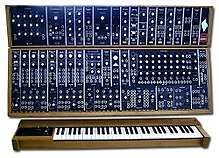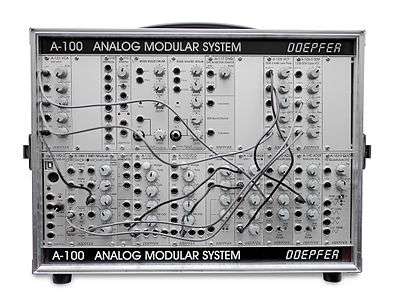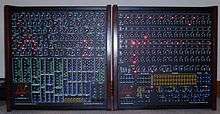Modular synthesizer
The modular synthesizer is a type of synthesizer, which exists in both physical and virtual forms, consisting of separate specialized modules. The specialization is usually in the module being designed to allow the modification or processing of one parameter of a signal, such as the frequency (oscillator), spectrum (filter), or amplitude (amplifier). The modules are not hardwired together but are connected together with patch cords, a matrix patching system, or switches to create a patch. The voltages from the modules may function as (audio) signals, control voltages, or logic conditions.




Types of modules
There are two basic kinds of modules: source and processor. [1] The basic modular functions are: signal, control, logic/timing. Outputs are an electric voltage.
There exist many different types of modules. There are basic modules, and compound modules, a compound module being a single module made up of several basic modules internally wired together. Examples of compound modules include the envelope follower, sequencer, and vocoder. Modules with the same basic functions may have different inputs, outputs and controls, depending on their degree of complexity. Some examples include the VCO, which may have options for sync (hard or soft), linear or exponential frequency modulation, and variable waveshape; the VCF that may have both resonance and bandwidth controls; and the envelope follower which may provide outputs at each stage of the process. There are some standards which manufacturers followed for their range of physical synthesizers, such as 1V/oct control voltages, and gate / trigger thresholds providing general compatibility; however, connecting synthesizers from different manufacturers may require cables with different kinds of plugs.
Some standard modules found on almost any modular synthesiver are:
Sources - characterized by an output, but no signal input; it may have control inputs:
- VCO – Voltage Controlled Oscillator, a continuous voltage source, which will output a signal whose frequency is a function of the settings. In its basic form these may be simple waveforms (most usually a square wave or a sawtooth wave, but also includes pulse, triangle and sine waves), however these can be dynamically changed through such controls as sync, frequency modulation, and self-modulation.
- Noise source - A source that outputs a random voltage. Common types of noise offered by modular synthesizers include white, pink, and low frequency noise.
- LFO - A Low Frequency Oscillator may or may not be voltage-controlled. It may be operated with a period anywhere from a fortieth of a second to several minutes. It is generally used as a control voltage for another module. For example, modulating a VCO will produce frequency modulation, and may create vibrato, while modulating a VCA will produce amplitude modulation, and may create tremolo, depending on the control frequency. The rectangular wave can be used as a logic / timing / trigger function.
- EG - An envelope generator is a transient voltage source. A trigger in the presence of a gate, applied to an Envelope Generator produces a single, shaped voltage. Often configured as ADSR (Attack, Decay, Sustain, Release) it provides a transient voltage that rises and falls. It can be triggered by a keyboard or by another module in the system that produces a rapidly rising trigger in the presence of a gate. Usually it controls the amplitude of a VCA or the cutoff frequency of a VCF, but the patchable structure of the synthesizer makes it possible to use the envelope generator to modulate other parameters such as the frequency or pulse width of the VCO. Simpler EGs (AD or AR) or more complex (DADSR—Delay, Attack, Decay, Sustain, Release) are sometimes available.
- Sequencer, also sometimes called an Analog Step Sequencer, is a family of compound module types which may be a source or a processor, see also below. As a source, depending upon the configuration, it may produce a sequence of voltages, usually set by adjusting values on front panel knobs. The sequencer may also output a trigger, and/or gate, at each step (stage). Sequencers are stepped by a trigger being applied to the trigger input. Designs may allow for stepping forwards or backwards, oscillating patterns, random order, or only using a limited number of stages. An example of an analog sequencer and controller with this level of complexity is the Doepfer A-154, A-155 combination.
Processors - characterized by a signal input and an output; it may have control inputs.
- VCF - Voltage Controlled Filter, which attenuates frequencies below (high-pass), above (low-pass) or both below and above (band-pass) a certain frequency. VCFs can also be configured to provide band-reject (notch), whereby the high and low frequencies remain while the middle frequencies are attenuated. Most VCFs have variable resonance, sometimes voltage-controlled.
- VCA - Voltage Controlled Amplifier, is usually a unity-gain amplifier which varies the amplitude of a signal in response to an applied control voltage. The response curve may be linear or exponential. Also called a two-quadrant multiplier.
- LPG - Low Pass Gate, is a compound module, similar to a VCA and a VCF, except that the circuit uses a Resistive_opto-isolator (vactrol) to respond to the control voltage, which also filters the sound as it amplifies, allowing more high frequency information through at higher amplifications.
- RM - Ring modulator - Two audio inputs are utilized to create sum and difference frequencies while suppressing the original signals. Also called a four-quadrant multiplier or balanced modulator.
- Mixer - a module that adds voltages.
- Slew limiter - is usually a sub-audio lowpass filter. When used in a control voltage path to an oscillator, this can be used to create glide or portamento between frequencies.
- S&H - Sample and hold, is usually used as a control-voltage processor. Depending upon the design, usually an ascending edge (trigger), captures the value of the voltage at the input, and outputs this voltage until the trigger input reads another voltage and repeats the process.
- Sequencer, (see also above), as a processor, may have a signal input into each step, (location or stage), which is output, when stepped to. An example of this type of sequencer is the Doepfer A-155.
- Custom Control Inputs - It is possible to connect any kind of voltage to a modular synthesizer as long as it remains in the usable voltage range of the instrument, usually -15V to +15V.
Modular synthesizers can be bulky and expensive. Due to the continuously variable nature of knobs and sliders, reproducing an exact patch can be difficult or next to impossible. In the late 1970s, modular synthesizers started to be largely supplanted in pop music by highly integrated keyboard synthesizers, racks of MIDI-connected gear, and samplers. However, there continued to be a community who chose the physically patched approach, the flexibility and the sound of traditional modular systems. Since the late 1990s, there has been a resurgence in the popularity of analog synthesizers aided by physical standardization practices, an increase in 'retro' gear and interest, decreased production costs and increased electronic reliability and stability, the rediscovered ability of modules to control things other than sound, and a generally heightened education through the development of virtual synthesis systems such as MAX/MSP, Pd and Reaktor etc.
Function of modules

There are three principal functions in a modular synthesizer: •(audio) signal, • control and • logic. The function is not determined by the module, rather by how it is used. For example, an oscillator may function as an [audio] signal when the output is routed [eventually] to a loudspeaker; a control when the output controls a parameter of another module; and logic when providing a logic function, such as a clock, trigger, gate or sync.
Historic manufacturers
The earliest commercial modular synthesizers were developed, in parallel, by R.A. Moog Co., and Buchla in 1963. Their designs drew from innovations by inventor Hugh Le Caine, particularly his implementation of control voltage in the electronic sackbut. The synthesizer both broadened the spectrum, and greatly eased the creation of electronic music, which before was made via tape splicing, use of primitive electronic oscillators, and earlier electronic or electromechanical instruments such as the theremin and the Ondes Martenot. ARP (in 1970), Serge (1974), and EMS (1969) versions were soon to follow.
Japanese company Roland released the Roland System 100 in 1975,[2] followed by the Roland System 700 in 1976. Also in the 1970s, there were at least two mail-order electronics kit vendors Paia Electronics, and Aries, marketing different lines of simple DIY modular synthesizer systems. The Aries system was modeled on the circuits produced by Bernie Hutchins and published as Electronotes. In the UK in the 1980s the Digisound 80 Modular Synthesizer, designed primarily by Charles Blakey, was sold as a kit by the company Digisound Ltd. Many of the early modules appeared in the early to mid-1980s as construction articles in two British electronics magazines - Electronics Today International (ETI) and Electronics & Music Maker (E&MM).[3] Joseph A. Paradiso's Massive Modular Synth is among the world's largest home-designed and built synthesizers.
Modern manufacturers of modular hardware synthesizers (alphabetical)
Hardware offerings range from complete systems in cases to kits for hobbyist DIY constructors. Many manufacturers augment their range with products based on recent re-designs of classic modules; often both the original and subsequent reworked designs are available free on the internet, the original patents having lapsed. Many hobbyist designers also make available bare PCB boards and front panels for sale to other hobbyists.
- Buchla Electronic Musical Instruments (formerly Buchla & Associates)
- Doepfer Musikelektronik (A-100)
- Monde Synthesizer
- Monome
- Moog Music (formerly Big Briar, formerly Moog)
- Synthesis Technology
- PAiA Electronics
- Analogue Systems
- Sound Transform Systems
- Studio Electronics
- Synthesizers.com
- Synton Fenix
Technical specifications
Form Factors
Many early synthesizer modules had modules with height in integer inches: 11" (e.g., Roland 700), 10" (e.g., Wavemakers), 9" (e.g., Aries), 8" (e.g., ARP 2500), 7" (e.g., Polyfusion, Buchla, Serge), 6" (e.g., Emu) and width in 1/4" inch multiples. More recently it has become more popular to follow the standard 19" Rack unit system: 6U (Wiard), 5U (8.75" e.g., Moog/Modcan), 4U (e.g., Serge), 3U (Eurorack).
Two 3U unit standards in particular are notable: Frac Rack (e.g., Paia), which uses the entire 3U for the front panel, and Eurorack (e.g., Doepfer) which has a 2mm horizontal lip that the front panels are seated between. Further minor variations exist where European or Japanese manufacturers round a U measurement up or down to some closer convenient metric equivalent; for example the common 5U modules are exactly 8.75" (222.25mm), but non-American manufacturers may prefer 220mm or 230mm.
Electrical
Other differences are with plugs that match 1/4-inch or 6.3mm jacks, 3.5mm jacks, and banana jacks, with main DC power supply (typically ±15 V, but ranging from ±18 V to ±12 V for different manufacturers or systems), with trigger or gate voltages (Moog S-trigger or positive gate), with typical audio signal levels (often ±5 V with ±5 V headroom), and with control voltages of volts/octave (typically 1 V/octave, but in some cases 1.2 V/octave.) Most analog modular systems use a system in which the frequency is exponentially related to the pitch (such as 1 volt/octave or 1.2 volts/octave), sometimes called "linear" because the human ear perceives frequencies in a logarithmic fashion, with each octave having the same perceptual size; some synthesizers (such as Korg MS-20, ETI 4600) use a volts/hertz system, where the frequency (but not the perceived pitch) is linear in the voltage.
Modular software synthesizers (alphabetical)
There are also software synthesizers for personal computers which are organized as interconnectable modules. Many of these are virtual analog synthesizers, where the modules simulate hardware functionality. Some of them are also virtual modular systems, which simulate real historical modular synthesizers.
- AudioMulch
- Arturia Modular V
- Bidule
- ChucK
- CreamwareAudio Modular III
- Csound
- Doepfer
- MaxMSP
- Moog Model 15
- Kyma
- Pure Data
- Reaktor
- SunVox
- SuperCollider
- SynFactory
- VCV Rack[4]
- Wren for Windows (open-source)
Computers have grown so powerful and inexpensive that software programs can realistically model the signals, sounds, and patchability of modulars very well. While potentially lacking the physical presence of desirable analog sound generation, real voltage manipulation, knobs, sliders, cables, and LEDs, software modular synthesizers offer the infinite variations and visual patching at a more affordable price and in a compact form factor.
The popular plugin formats such as VST may be combined in a modular fashion.
Semi-modular synthesizers
A modular synthesizer has a case or frame into which arbitrary modules can be fitted; modules are usually connected together using patch cords and a system may include modules from different sources, as long as it fits the form factors of the case and uses the same electrical specifications.
A semi-modular synthesizer on the other hand is a collection of modules from a single manufacturer that makes a cohesive product, an instrument. Modules may not be swapped out and often a typical configuration has been pre-wired. However, the manufacturer provides mechanisms to allow the user to connect modules in different orders.
Matrix Systems
Matrix systems use pin matrixes or other crosspoint switches rather than patch cords. Historic examples with pin matrixes include the EMS Synthi 100, EMS VCS-3, ETI International 4600, Maplin 5600. The ARP 2500 used a matrix switch.
Patch Override Systems
The different modules of a semi-modular synthesizer are wired together into a typical configuration, but can be re-wired by the user using patch cords. Some examples are the ARP 2600, Anyware Instruments Semtex, Cwejman S1, EML101, Evenfall Minimodular, Future Retro XS, Korg MS-10, MS-20, MS-50, PS-3100, PS-3200 and PS-3300, Mungo Enterprises State Zero, Roland System 100 and Moog Mother-32 .
Electronically Reconfigurable Systems
Reconfigurable systems allow certain signals to be routed through modules in different orders. Examples include the Oberheim Matrix and Rhodes Chroma, and Moog Voyager.
Hybrid modular synthesizers
Hybrid synthesizers use hardware and software combination. In alphabetical order:
- Arturia Origin by Arturia (fully self-contained)
- Clavia Nord Modular and Clavia Nord Modular G2 (these need an external computer to edit patches)
- Audiocubes
See also
External links
- 120 years of Electronic Music has information on classic modular synths.
- Synthmuseum.com Resource for vintage synthesizer information and images.
- Modular Analog Synthesizers Return! Article about new modular systems.
- Modular Music TV Website dedicated to tutorials, news, performances and more using modular systems.
- Generalized Introduction to Modular Analog Synthesis Concepts] Article on modular analog synthesis concepts
- ModularSynth.co Network of modular synth manufacturers and producers.
References
- ↑ Austin, Kevin. "A Generalized Introduction to Modular Analogue Synthesis Concepts." eContact! 17.4 Analogue and Modular Synthesis: Resurgence and evolution (February 2016). Montréal: CEC.
- ↑ Rudi Esch, Electri_City: The Düsseldorf School of Electronic Music, page 257, Omnibus Press
- ↑ Digisound 80 Modular Synthesizer
- ↑ Michel, Cindy (2018-01-05). "Dreht am virtuellen Synthesizer". WIRED (in German). Retrieved 3 April 2018.
Further reading
- Austin, Kevin - Introduction to the Analog Synthesizer (1984 - 2017), Concordia University, Montreal, Canada